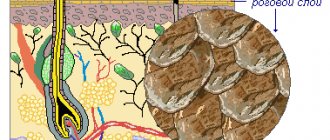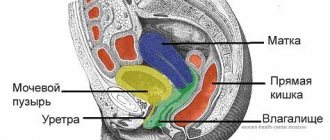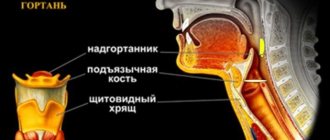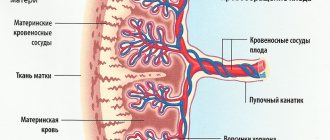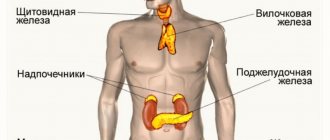What parts does the human hearing organ consist of?
- Outer ear
- Middle ear
- Inner ear.
Outer ear
The outer ear is the only externally visible part of the hearing organ. It consists of:
- The pinna, which collects sounds and directs them to the external auditory canal.
- The external auditory canal, which is designed to conduct sound vibrations from the auricle into the tympanic cavity of the middle ear. Its length in adults is approximately 2.6 cm. Also, the surface of the external auditory canal contains sebaceous glands that secrete earwax, which protects the ear from germs and bacteria.
- The eardrum that separates the outer ear from the middle ear.
Middle ear
The middle ear is an air-filled cavity behind the eardrum. It is connected to the nasopharynx by the eustachian tube, which equalizes the pressure on both sides of the eardrum. That is why, if a person’s ears are blocked, he reflexively begins to yawn or make swallowing movements. Also in the middle ear are the smallest bones of the human skeleton: the hammer, incus and stirrup. They are not only responsible for transmitting sound vibrations from the outer ear to the inner ear, but also amplify them.
Inner ear
The inner ear is the most complex part of hearing, which, due to its intricate shape, is also called the labyrinth. It consists of:
- The vestibule and semicircular canals, which are responsible for the sense of balance and body position in space.
- Snails filled with liquid. It is here that sound vibrations enter in the form of vibration. Inside the cochlea is the organ of Corti, which is directly responsible for hearing. It contains about 30,000 hair cells that detect sound vibrations and transmit the signal to the auditory area of the cerebral cortex. It is interesting that each of the hair cells reacts to a certain sound purity, which is why, when they die, hearing loss occurs and a person stops hearing sounds of the frequency for which the dead cell was responsible.
From sound wave to hearing
Sound plays a vital role in the lives of most people. It allows us to communicate and receive information, enjoy the sounds of nature and listen to music. Sound can also warn us of danger.
All sounds arise as a result of movements. For example, when the wind blows, leaves move on the trees. Leaves move air molecules, causing them to vibrate. These vibrations are called sound waves and can be perceived by the human ear.
Slow vibrations (low frequencies) are perceived as low sounds (bass), while fast vibrations (high frequencies) are perceived as high sounds (treble).
The human ear is a complex and sensitive organ that consists of three main parts:
- The outer ear consists of the pinna (the outer cartilaginous part of the ear) and the ear canal. At the end of the ear canal is the eardrum, which separates the outer ear from the middle ear. The outer ear works like a satellite dish - it picks up sound waves and conducts them into the ear canal.
- The middle ear is an air-filled space in which the air pressure is regulated by the Eustachian tube, which connects the pharynx to the tympanic cavity of the middle ear. The middle ear contains three tiny bones - the malleus, incus and stirrup. These ossicles form a lever mechanism that conducts vibrations from the eardrum into the inner ear, the so-called cochlea. These bones are associated with two muscles that contract when very loud sounds enter the ear. These muscles reduce the effect of excessive sound pressure in the inner ear.
- The inner ear, the so-called cochlea, is shaped like a cochlea shell and filled with fluid. Associated with the cochlea is the vestibular apparatus, which consists of three semicircular canals filled with fluid. The middle ear and inner ear are connected through the oval window. Connected to the oval window is the base of the stapes, which acts like a piston that presses on the fluid in the inner ear.
The movement of fluid activates the hair cells in the inner ear (there are about 20,000 of these “sensitive cells”). When excited, hair cells send impulses along the auditory nerve to the brain, which perceives these impulses as sound.
In this bizarre and complex way, the ear is able to capture sound waves, convert them first into vibrations of the bones, then into the movement of fluid and, ultimately, into nerve impulses that are perceived by the brain. Even the slightest damage to this complex system can negatively affect hearing.
Features of the hearing organ
The human hearing organ differs from the ear of most other land mammals:
- location and shape of the outer ear;
- lack of mobility of the auricle;
- perception of a less wide range of frequencies.
Such imperfect anatomy and physiology of the human hearing organ in comparison with representatives of the animal world is due to the fact that humans are at the top of the food chain (he does not need to be constantly on alert to avoid becoming a victim of a predator) and the lack of the daily need to obtain food by hunting.
However, these minor shortcomings are more than compensated by the main advantage - the developed auditory cortex of the brain, which provides the ability to verbally communicate, which is unique to humans. Return to list
Structure of the hearing organ
The human hearing organ consists of three parts that perform different functions. The loss of at least one of them results in hearing loss. Divisions of the hearing organ:
- Peripheral - capturing a sound wave and transforming it into a wave of nervous excitement. Consists of the outer, middle and inner ear.
- Conductor – the auditory nerve that transmits nerve impulses to the brain.
- The central part is the area of the cerebral cortex that analyzes the signal.
Outer ear
The outer ear picks up the sound signal, amplifies it and transmits it to the structures of the middle ear. This department includes:
- auricle - the shape of the funnel contributes to good sound capture, and its indentations and elevations increase the volume and reduce the resonance frequency;
- external auditory canal – amplifies the sound signal and protects the eardrum from adverse effects;
- The eardrum is a membrane made of connective tissue that connects the outer ear to the middle ear and transmits a mechanical wave to its structures.
Middle ear
The middle ear is a sinus (tympanic cavity) in the pyramid of the temporal bone, connected by the Eustachian canal to the nasopharynx. The canal maintains equal pressure between the outer and middle ear, through which ventilation and drainage of the latter is carried out. In the middle ear there are small auditory ossicles, connected to each other by movable joints:
- hammer;
- anvil;
- stapes.
Vibrations of the eardrum first set in motion the hammer connected to it, then the incus and stapes, from which the wave passes to the outer ear. The lever mechanism of the auditory ossicles increases the pressure when the wave passes through the middle ear by 1.5-2 times.
Inner ear
The inner ear is located in the temporal bone and acts as a natural microphone that transforms sound into an electrical wave. Sometimes it is called the organ of hearing and balance. The structure of the hearing organ (in a separate concept) is complex. It represents a collection of convoluted communicating channels and cavities, which explains its other name - “labyrinth”. The external (bone) labyrinth includes the following structures:
- part of the hearing organ is the cochlea;
- elements of the vestibular apparatus - the vestibule and 3 semicircular canals with receptors that transmit information about the position of the body to the brain.
The cochlea, a convoluted bony structure, is filled with lymph and connects to the tympanic cavity through the oval window, closed by the plate of the stapes. Mechanical vibrations of the stapes are transmitted through the lymph to the base of the cochlear canal - the basilar membrane and the organ of Corti located on it. This organ contains about hair cells with receptors. Receptors convert the sound signal into an electrical signal and transmit it higher through the neurons of the auditory nerve.
Since the elements of the organ of hearing and the organ of balance have a close anatomical connection in the area of the inner ear, damage (traumatic, inflammatory, ischemic) to tissues at this level is often simultaneously accompanied by a decrease in hearing function and imbalance - dizziness, unsteadiness of gait, sudden falls.
Conductor and central department
The electrical impulse travels along the auditory nerve (cranial nerve VIII pair) through the brain stem (medulla oblongata, midbrain, diencephalon). On the way to the central part, the auditory nerves cross, the signal from the left ear goes to the right hemisphere and vice versa. At the end of its path, the signal reaches the cerebral cortex - the auditory lobe of the temporal lobes, where it is analyzed. This allows a person to recognize and form (in early childhood) speech, identify sounds with their source, capture the tonal and emotional coloring of the interlocutor’s voice, musical melodies, and much more.
How does the ear work?
To understand the causes of hearing loss, you need to understand how the human ear works. Your ear is an amazing organ that carries sound information to your brain and causes you to respond in different ways to the sounds around you. They evoke emotions, curiosity in us, we react to laughter, crying, praise, sounds represent names. The ear can perceive a sound that is barely audible, very loud, determines the source of the sound, its volume and the distance to the sound source. You will see how the ear performs the task of hearing. Our ears are a complex organ. They sense air waves and convert them into “sounds” in our brains. The ears also control balance and largely determine our attitude towards the world around us. Our ability - or inability - to hear affects almost every aspect of our lives.
The nature of sound . Sounds are air waves or vibrations that are felt by a healthy ear. These vibrations are characterized by frequency (pitch) and amplitude (loudness). Frequency is defined as the number of vibrations per second and is measured in Hertz. The higher the frequency, the higher the sound, and vice versa. An example of a high-pitched sound is (piglet) or birdsong. Low sounds include distant rumbles of thunder or bass sounds in music.
Sound pressure level . Sound pressure level is expressed in decibels (dB). However, sound pressure level should not be confused with loudness. For example, an alarm clock will sound much louder than a dog growling, even if both sounds have the same sound pressure level. Therefore, loudness is a subjective value and cannot be measured accurately.
Complex sounds . Different sounds have different characteristics. Simple sounds, such as pure tones, are vibrations of a single frequency, while complex sounds are composed of vibrations of different frequencies. Most of the sounds we hear every day are complex. Speech, for example, consists of vibrations with different volume levels at different frequencies. Typically the range of these frequencies is from 500 to 3000 Hz.
How the ear works . The human ear receives sound waves and converts them into signals that travel to the brain, where they are analyzed and interpreted. Perhaps the best way to explain the workings of the ear is to describe the path that sound takes through the different parts of the ear. 1-Outer ear Collects sound waves and directs them into the ear canal, where they are amplified by its funnel-shaped shape. The auditory canal ends in the eardrum.
2-Middle Ear The middle ear is an air-filled chamber connected to the nasal and throat passages by the Eustachian tube, which is designed to equalize the sound pressure on either side of the eardrum. The Eustachian tube usually closes and opens naturally when you swallow or yawn. Sound waves cause vibrations in the eardrum, which are transmitted along the chain of auditory ossicles attached to it. These smallest human bones are called the malleus, incus and stapes. They mechanically connect the eardrum with the oval window of the inner ear. 3-Inner ear. The main part of the fluid-filled inner ear is coiled and is therefore called the cochlea. The cochlea contains approximately 20,000 microscopic sensory cells connected to auditory nerve fibers and ending in hairs. Different groups of these hair cells respond to different vibration frequencies. Once in the cochlea, the converted sound waves cause oscillations in electrical impulses that are sent to the brain. Here these impulses are interpreted as meaningful sounds.
What is the organ of hearing and balance?
The organ of hearing and balance, or ear, is a whole system, a collection of several organs responsible for human perception of sounds and coordination of movements. The structures that provide hearing and balance are closely interconnected functionally and anatomically. Main functions of the ear:
- functions of the organ of hearing - perception of a sound signal and its conversion into an electrical (nerve impulse);
- functions of the organ of balance - determining the position of the body in space and converting information into nervous excitation.
The ear is the common peripheral part of the auditory and vestibular analyzers; the ascending transmission of nerve impulses from the vestibular and auditory parts occurs through different channels to different structures of the brain. The organ of hearing in general terms (the auditory system, the auditory analyzer, which includes, in addition to the peripheral, other departments) is the second most important sensory system after vision, allowing one to perceive and analyze information coming from sources located at a distance.
Description of internal parts, their functions and location
The structure of a small part of the human hearing system - the middle ear - deserves a detailed description because of its significance:
- The eardrum is located on the border of the outer and middle ear. Through it, external sound waves, causing its vibrations, enter the middle ear. It is a two-layer, fibrous oval plate of connective tissue. On the outside it is covered with epithelium, and on the side of the cavity of the same name, like its other walls, it is covered with a mucous membrane. Its diameter is about a centimeter, and its thickness is only a tenth of a millimeter. In the center of this organoid, at the site of attachment of one of the auditory ossicles - the malleus - there is a tiny hollow, reminiscent of a navel.
- Tympanic cavity contains 3 auditory ossicles, tiny tendons and muscles that cause tension on the eardrum and stapes. A part of the facial nerve passes through it - the string of the same name.
A continuation of this area is auditory tube. In one of the six walls of this cavity - the labyrinth - there are 2 windows.One of them, the vestibule, is closed by the stirrup, and the second, the window of the cochlea, is blocked by the secondary tympanic membrane. The posterior septum of the cavity has an entrance to the mastoid cell.
- The auditory ossicles ensure the transmission of sound waves from the eardrum to the oval window of the vestibule of the inner ear. Their names—hammer, incus, and stapes—refer to their shape and function. This is a kind of lever system, held together by joints and ligaments. The handle of the malleus is connected to the eardrum, its head is connected to the incus, the latter, in turn, comes into contact with the head of the stapes. The stapes is separated from the inner ear by the vestibule. All auditory ossicles are covered with mucous membrane. The stapes is the smallest and lightest human bone, measuring less than half a centimeter and weighing only 2.5 mg.
- In the middle section of the auditory apparatus there are also the smallest muscles in humans - the tympanic and stapedius . One of them provides tension to the membrane of the same name, and the other, in combination with ligaments and joints, regulates the movements of the auditory ossicles and supports them. These tiny muscles also contribute to the accommodation (adaptation) of this part of the ear to the sound amplitude (in strength and height), thereby protecting the inner ear from strong sound stimuli.
- Air-filled mastoid cells are located in the posterior process of the temporal bone. They are directly connected to the tympanic cavity.
The Eustachian tube is one-third bone, and two-thirds cartilage. The diameter of the organ covered with the mucous membrane is about 2 mm, and the length is 3.5 cm. Its cartilaginous part is constantly tightly closed and opens only when swallowing. Its purpose is to equalize the pressure in the main cavity of the ear during fluctuations in atmospheric pressure. This is achieved through reflex yawning.
Another striking manifestation of the protective function of the auditory tube is the rapid blocking of the ears during a sharp change in pressure, for example, when climbing high in the mountains or descending an airplane during landing.
